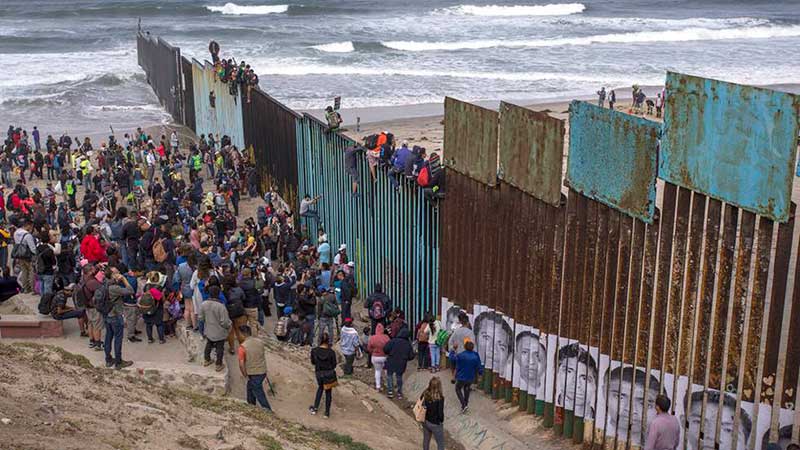CBP and ICE agents helped catch 240 “coyotes” in a single June week, according to DHS briefing materials prepared for the White House.
Arrests of undocumented migrants crossing the U.S. southern border have fallen by nearly 14 percent from an all-time high in May, driven in part by an increase in U.S.-assisted arrests of smugglers in Central America, far from U.S. soil, according to internal briefing materials obtained by NBC News.
Agents from Customs and Border Protection, as well as Immigration and Customs Enforcement’s Homeland Security Investigations, some of them in Central American countries, were responsible for the arrests of an average of 240 smugglers in a single week in June, according to the materials, prepared by the Department of Homeland Security for a White House briefing.
Agents working outside the U.S. provide intelligence to local law enforcement on smugglers to target for arrests, according to the document.
More than 1,300 DHS personnel are focused on targeting smugglers, and the agency has spent more than $50 million on the effort since April, a DHS spokesperson said.
The number of smuggler arrests in Central and Latin American countries increased in June, and the number of undocumented migrants crossing the U.S.-Mexico border began to fall from May’s high of more than 7,700 daily apprehensions.
By the end of June, the numbers had fallen by 14 percent, and they have stayed relatively stagnant. In the first two weeks of July, the average number of undocumented migrants being stopped at the southern land border every day was 6,800, according to preliminary figures shared internally at CBP and obtained by NBC News.
Seasonal trends are also responsible for the drop, as in most years fewer migrants make the journey during the hot summer months. But monthly numbers actually rose in the summers of 2018, 2020 and 2021. And while the early months of 2022 had record levels of border traffic, crossings this July are on pace to fall below those of the same month last year.
Human smugglers, also known as coyotes, are often connected to drug cartels and charge migrants thousands of dollars to be transported to the U.S. on dangerous journeys on which some are kidnapped, assaulted or left for dead. Smuggler networks are so widespread throughout the region that it is extremely rare for an undocumented migrant to cross the U.S. southern border on foot without the help of a smuggler.
In the briefing materials, DHS estimated that for each smuggler stopped, 24 migrants were either stopped or slowed from crossing the border. DHS credited the smuggler arrests with stopping as many as 1,329 migrants a day.
The Biden administration has boasted of its increased partnership and coordination with governments and law enforcement agencies in Mexico, as well as Central and South America. But the scale of the role U.S. immigration agents play in the arrests of smugglers outside the U.S. has remained largely covert.
The briefing materials reveal that during one week in late June, CBP agents were responsible for the arrests of 166 smugglers and ICE’s Homeland Security Investigations agents were responsible for 74 arrests outside the U.S. The agents also helped discover stash houses and trailers carrying migrants in Central America.
Sergio Gonzales, the executive director of The Immigration Hub, which advocates for progressive immigration policies, said U.S. voters largely support the arrests of human smugglers, but he cautioned that the Biden administration needs to do more to open safe, legal pathways for asylum-seekers.
“These are really bad actors that prey on people in really desperate and difficult situations,” Gonzales said of human smugglers. “But you can’t just take away pathways for people to seek safety.”
Gonzales also said the details of how ICE and CBP are working in the region matter because of the “problematic history of U.S. law enforcement in Latin America that has caused major problems in the region.”
The level of involvement by U.S. immigration agents with law enforcement agents physically making the arrests is unclear, but the briefing materials suggest U.S. agents keep a tally of exactly which arrests they help facilitate.
“Further strengthening our security partnerships throughout the hemisphere is a priority for DHS as we escalate our law enforcement operations against the smugglers and traffickers who prey on the vulnerable,” said DHS Secretary Alejandro Mayorkas. “Fluctuations are normal, but we will continue to strengthen our border security, support our partners, and combat transnational crime and human smuggling vigorously.”
In a statement, a White House official said, “President Biden is taking historic action to disrupt the criminal smuggling networks that are profiting off of migrants, and he brought 20 world leaders together for the first time to do it with him. In just the last two weeks, these efforts resulted in 706 smuggler arrests, and helped prevent up to 1,900 migrants a day from falling prey to dangerous smugglers.” (https://www.nbcnews.com/politics/immigration/number-migrants-crossing-border-dropping-part-due-us-agents-helping-na-rcna40528)



































